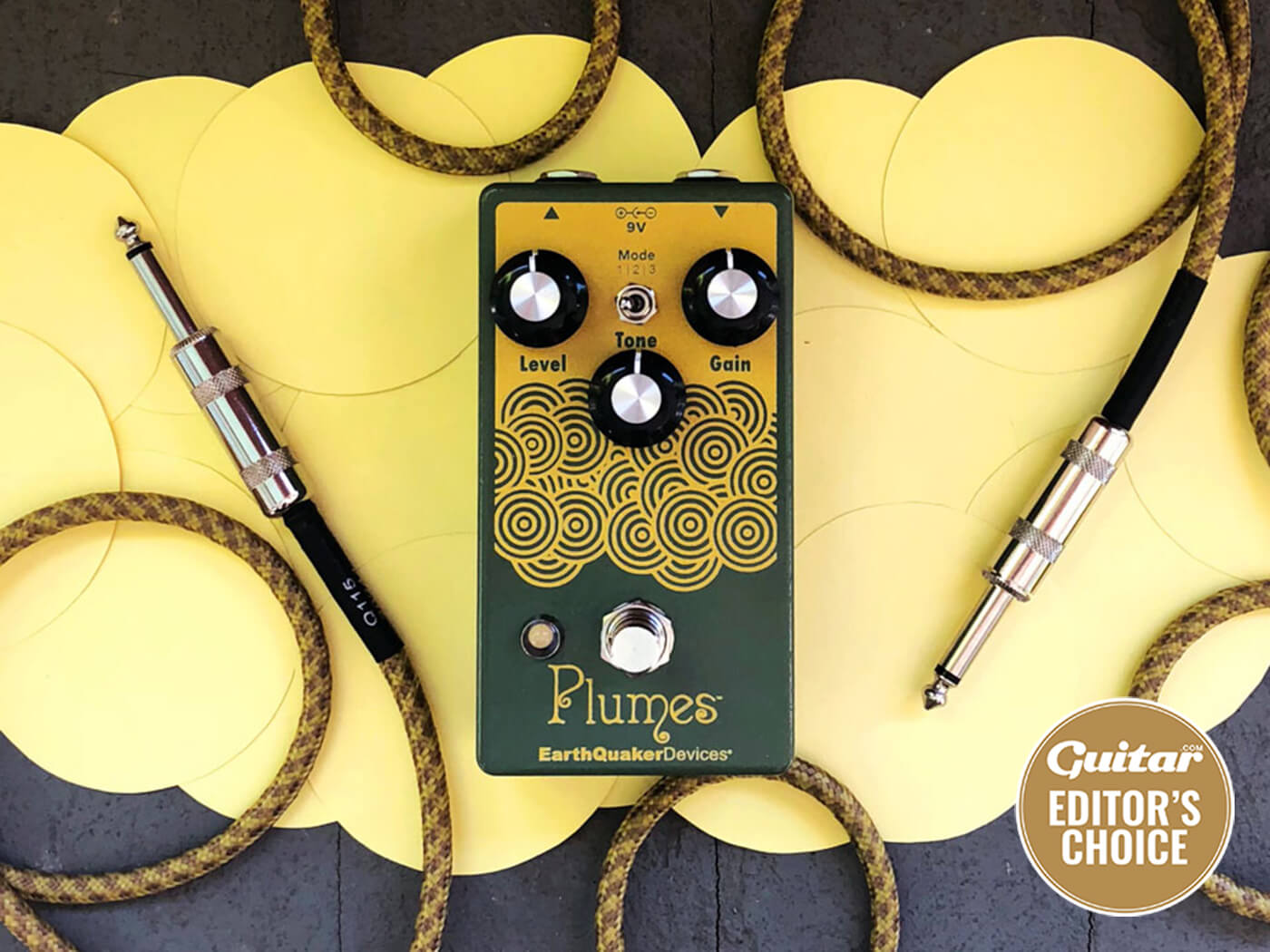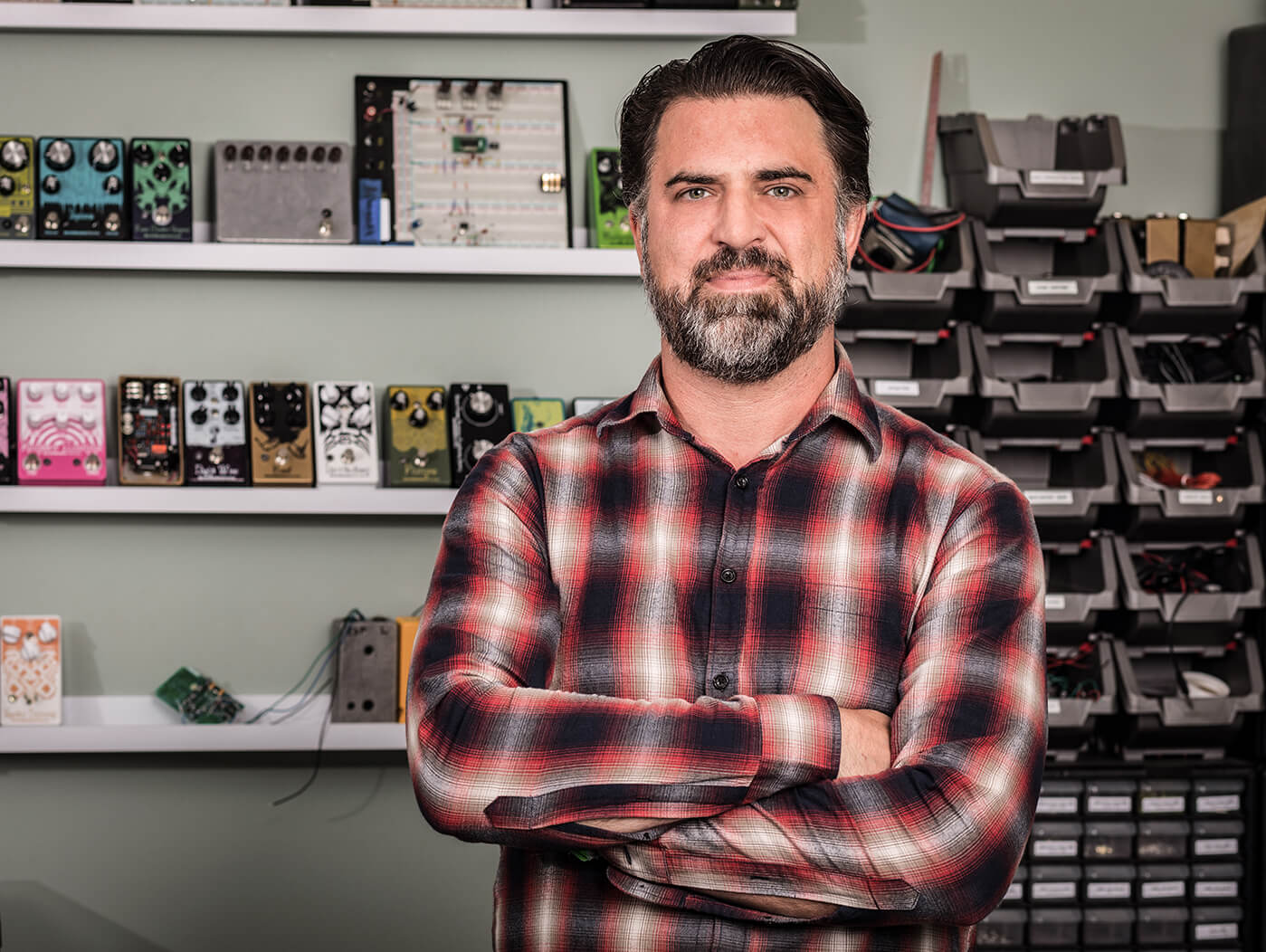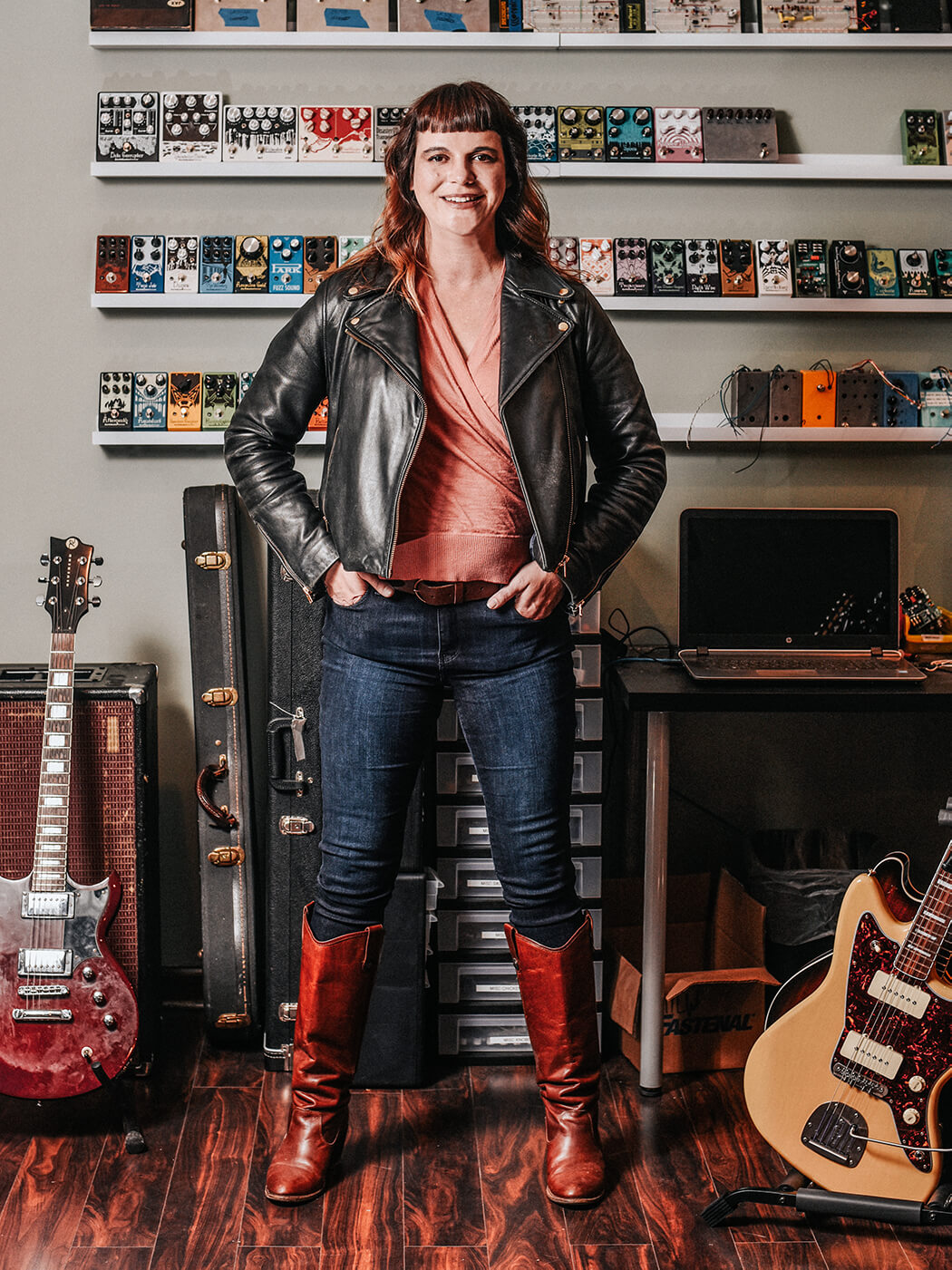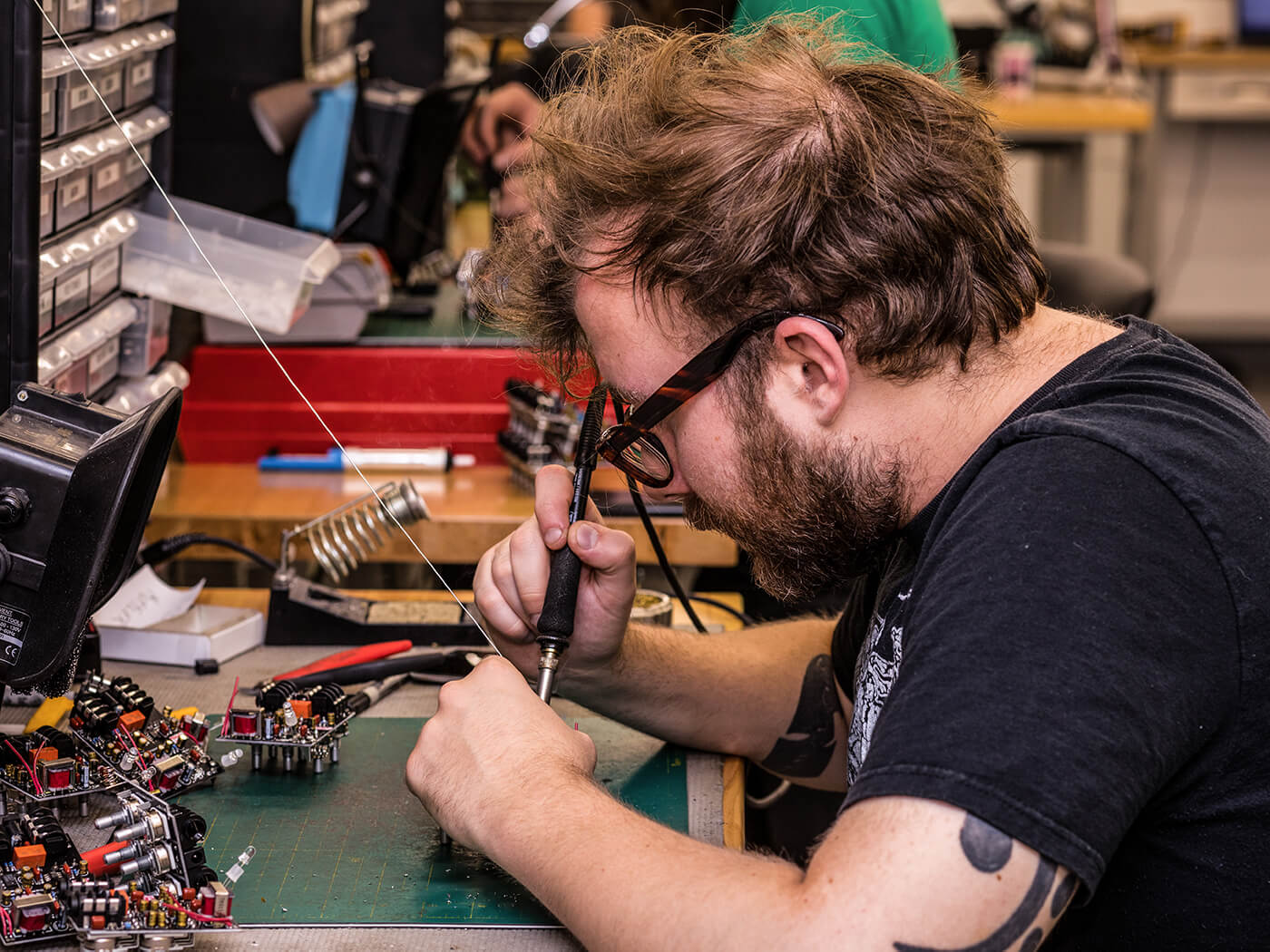Related Tags
Jamie Stillman and Julie Robbins of EarthQuaker Devices talk working with Sunn O)))
Can you still fly the ‘boutique’ flag once your roster hits 50 employees and you’ve won a Small Business Exporter Of The Year Award? EQD’s Jamie Stillman and Julie Robbins talk maintaining the small-shop attitude in a big-shop world.

Although he played guitar in several notable bands himself (Ohio hardcore outfit The Party Of Helicopters among them), Jamie Stillman mainly segued into the pedal-making business via his gig as tour manager for one of the world’s most popular indie bands of the 2000s, The Black Keys, which found him building pedals for pal Dan Auerbach’s board on the side.
After founding EarthQuaker Devices in 2004 or early ’05 in a basement in Akron, Ohio, Stillman released EQD’s first production-run pedal, the Hoof fuzz, in ’07. He continued working with The Black Keys up until 2010’s breakout smash album Brothers, but the pedal business quickly escalated from a project to a business that demanded his full attention.

Stillman’s wife, Julie Robbins, joined the company full-time in 2011 as CEO to help him keep it all growing, bringing with her a wealth of business nous from her previous positions heading a talent agency and working in the banking industry, and EQD was driving full-steam ahead.
Throughout the boom, the brand became known as a company that wasn’t afraid to reinvent some beloved classics, while offering several fun and original new designs that nevertheless presented original and usable sounds, rather than merely shooting for the aural extremes for which some small makers strove as the field got more and more crowded. It was – and remains – a winning formula, and EQD has thrived.
Sound explosion
“I feel like around 2010-ish, somewhere in that area, was when [the pedal market] really exploded,” says Stillman. “And… I still feel you can tell which companies are going to stick and which ones aren’t. And it almost has nothing to do with how cool or unique the products are; it’s more to do with the things around every company: their general vibe, or the other things that they do.”

While some of EQD’s pedals might seem rather ‘out there’ – consider the Afterneath reverb/delay, the Data Corrupter Modulating Monophonic Harmonizing PLL, or the Disaster Transporter SR modulated delay and reverb – each proves an eminently usable effect, with massive creative potential and pretty instantly gratifying results once you start turning some knobs.
“I think even the stuff that people regard as ‘crazy’ in the EarthQuaker line really isn’t that wild by comparison to some of the things that are coming out now,” says Stillman. “And a lot of the things are way above my personal patience to get. I don’t want to sit and read a manual for a full day and then spend a week tweaking something to make the most insane sound I’ve ever heard.
“I’d rather turn a couple knobs and play through it and be like, ‘that’s what it does!’ That’s my personal preference and it’s also why we don’t have a lot of pedals where you’ve got to look at the manual to figure out a feature. I think there are more guitar players now who are more tolerant of those learning curves and MIDI-diving and stuff. I’m not one of them.”

Robbins sums up the EQD pedal line this way: “We have a lot of pedals you could use to replace something that already existed on your pedalboard to go on tour on a record you already wrote. And then another portion of our line is probably better to help inspire you to write your next record.”
“Another thing I battle with when designing stuff,” Stillman relates, “is you can kind of make any DSP-based pedal do anything – it can be a reverb, a distortion, a delay – but it can’t really do a good job of each one and it can’t use more than a couple at a time without making it this huge pedal. I don’t know, really, how useful all-in-one, small-format pedals are. I’d rather have one pedal that does one thing and does it well. And I kind of think the point of having this stuff is to add to making music more interesting or fun or whatever, not to try to solve a math equation.”
That being said, while plenty of companies are pushing toward the outer fringes of sonic mayhem to get attention, Stillman still sees a lot of love out there for the old standbys, and loads of companies are doing perfectly well cranking them out: “I think I still see new pedal companies starting up that have the standards, like a Big Muff, or a RAT, or a Tube Screamer, or just a regular clean boost. I don’t think people are sick of that stuff either. People still get really excited about it.”
Illusive effects
Like any creative designer and manufacturer, there are likely to have been some ideas with exciting potential that just didn’t pan out. Curious to hear what might fit that column for such an adventurous maker as EQD, I probed Stillman about the ones that got away.
“Yeah, there have been a few,” he confesses, “but they’re all kind of still in progress. I like to keep them secret. There’s one thing in particular that probably will never come out, because at this point, the parts are really hard to find. I won’t call it a pitch-shifter, but it changed the pitch and was kind of a harmoniser… more of a phaser-y pedal built around an NIC that was designed for voice-changing megaphones.

“I have been working on something that uses that for eight years and it almost came out. We did a little documentary a couple years ago and there’s a quick shot of that pedal, called Sonic Reducer. We had enclosures, we had the circuit board and then at the last minute, I was like, ‘This really isn’t as cool as it should be…’
“It went back to the drawing board and we’re still working on it. And every time I take it out – like, once a year – and play with it, for like the first 10 minutes I think it’s amazing and ready and then I find something about it that I have to go back to.”
And then there are the R&D efforts that never quite came to fruition in and of themselves, but which spawned something else that’s simultaneously unexpected, unplanned for, and wonderful: “That stuff can end up being cool. The Afterneath was like that and Bit Commander and Organizer and stuff like that. I think any more, a lot of times I have a crazier idea and it either becomes unachievable with what we have to work with, or tamer than I envisioned.”
Grand design
Although he still conceives all of EQD’s new pedals and designs the majority of them, Stillman has more help these days than he did when he was breadboarding in the basement, particularly with the more complex delay and modulation effects. He works closely with a third-party that does the platform that Avalanche Run and Pyramids are built on, for example, “because it’s way over my head as far as the DSP.” And even beyond that, a lot of effort involves outsourcing the manufacture of power supplies and the circuit board layouts and that sort of thing.
“And I work with them to come up with the algorithm,” he elaborates. “It’s more of saying: ‘Here’s what I want to do, a delay and reverb,’ and I sit beside him and play guitar through it and tell him what to change.”
When quizzed about his favourite new product of the past year or two, Stillman presents an answer that might seem surprising for a guitarist and effects nut who revels in noise-crafting and sonic melding.
“Swiss Things,” he declares without hesitation. “I made it initially just for my own – well, that can be said for a lot of things that we make – initially, just for my pedalboard and then got very excited about it, because it solves a tonne of problems that I’ve always had: with volume pedals, and being able to remove all of your effects out of the chain, reducing noise, making everything sound clearer. It exceeded my expectations and I was super happy about it. But when I first started trying to tell people about it, they were like, ‘So… it’s an A/B/Y box? A booster?’

“Then when you see it in use… I think even when it first came out, a lot of people bought it just because they were excited for a new EarthQuaker pedal and didn’t realise how useful it was until they started using it. I had a lot of people come up to me at the NAMM Show this year to say they were just curious, and now they don’t know how they ever got their pedalboard together without it. I think that’s the thing I’ve been most excited about in a long time.”
Trend setters
Although EQD has forged no end of new sounds, the company tends to resist mass trends in the industry and very much paves its own road instead. Among recent flavours-of-the-month that they’ll be avoiding, Stillman observes, “I feel like we’re currently watching granular delays explode. People are way into those at the moment and I’ve never seen anybody use one live. Maybe I’m watching the wrong bands or something, but it seems like there’s a lot of those popping up. I like that sound, but I’ve never been drawn to make something like that.”
Asked whether the broad range of effects in the EQD lineup appeals particularly to one breed or genre of player, Robbins offers: “I would definitely say they’re used by all kind of players, although the overwhelming majority of people who work here have more experimental tastes, and probably lean more toward new rock and metal or experimental stuff. But all kinds of people use our pedals.”
Among the more extreme of such users, EQD recently designed and manufactured a pedal in collaboration with the American drone-metal band Sunn O))), an eponymously named distortion in an enigmatic black box with two footswitches and the knobs on the forward face of the housing.
“It’s our first artist-collaboration pedal,” says Stillman. “It was a pretty awesome experience, and they had their hands on everything. Stephen, one of the guitar players, did all the artwork for the pedal and the packaging and they worked directly on the sound of the pedal and everything in it is exactly what they wanted. I made one version of the pedal and gave it to them and said: ‘This is what I like.’ And they were like, ‘Nope, this is what we want!’ And we pretty much worked hand-in-hand to develop this pedal. It just came out [in mid July] and the first run of them was 1,000 and it sold out in six hours!”
“We’re doing two more colourways in the next few months,” adds Julie, “and soon we’ll be working out the exact release dates and how they’re going to be distributed.”
Then, moving on to discuss EQD’s latest offering, both Stillman and Robbins first note the irony, given our earlier talk of companies cranking out ‘the standards’ in the wake of the Akron manufacturer’s unbridled originality.
“It’s kind of funny what it is, after what we were talking about,” Stillman hedges. “We’re coming out with a Tube Screamer! It’s called Plumes. I came up with the idea when we were working on Palisades, so it’s an idea that’s been around since the Palisades development, so it is much more straightforward than something like that and has a closer sound to the traditional Tube Screamer than the Palisades does.”
“The way that I would describe it is it’s more of a hi-fi version of the Tube Screamer. It uses JFETS and input and output buffers and that just makes everything. There’s a little more presence to it, and lower noise. It’s louder and has more headroom, and the sound is… I want to say ‘stiffer’, but that’s not the right word for it, because it doesn’t sound ‘stiff’.
“It has a three-way clipping switch, which gives no clipping for a clean boost, symmetrical clipping like in a Tube Screamer and asymmetrical clipping that’s sorta’ like a setting that I really liked on that Landgraff Dynamic Overdrive, it’s something similar to that. And the tone control is really useful all the way, it keeps more bass but there’s also more high end.
“It’s a very loud and cutting pedal, but still has the recognisable Tube Screamer sound to it. It’s a small-format pedal and it’s got a lower price point than pretty much all of our other pedals. It retails at $99. There’s a lot of ‘em around, but this one’s really useful. I like it a lot.”
But don’t take this long-awaited release of the EQD Screamer-alike as an indication of some kind of right turn toward Normalsville for this creative manufacturer.
“I guess I can share that after this, it’s probably going to be the last ‘normal’ pedal for a while,” says Stillman. “There’s going to be a lot of stuff coming out over the next year or two that’s a lot more experimental.”
Visit earthquakerdevices.com for more info and read our review of the Plumes pedal here.
